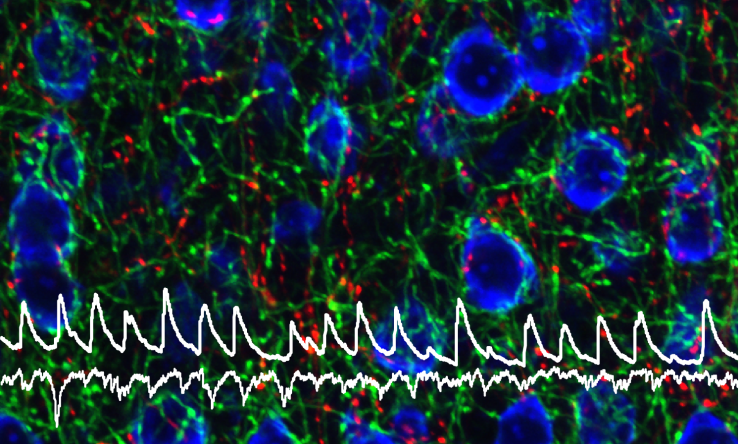Scientists turn unexpected results into research tool
Puzzled by their experimental results, a team of scientists from ▓▌┴±╔ńŪ°╚ļ┐┌ and Texas ChildrenŌĆÖs Hospital investigated why a research tool that was expected to suppress neuronal activity actually was stimulating it. Their findings led them to modify the research tool in ways that minimize the undesired effects, transforming it into a more useful technique to study neuronal function. The study appears in .
ŌĆ£One of the research goals of our laboratory is to understand how different classes of neurons in brain circuits interact with each other to perform their functions,ŌĆØ said corresponding author Dr. Mingshan Xue, assistant professor of neuroscience and of molecular and human genetics at ▓▌┴±╔ńŪ°╚ļ┐┌, Caroline DeLuca Scholar and member of the Cain Foundation Laboratories and the at Texas Children's Hospital. ŌĆ£One way to study neuronal function is by altering the activity of the neurons and then observe the outcomes, just like in genetics where scientists modify a gene to determine what it might do.ŌĆØ
Xue and his colleagues initially wanted to study the effect of inhibiting the activity of specific neurons in the visual cortex of mice. They used an optogenetic approach by which they genetically introduced into specific neurons a light-sensitive protein called light-gated chloride channel GtACR2, which was assumed to be an inhibitor of neural activity. The researchers then activated the inhibitory effect of GtACR2 by shining a light on the modified cells. It was expected that once it was light-activated, GtACR2 would inhibit the output of the neuronal activity, which the researchers measured as release of neurotransmitters.
ŌĆ£We expected that GtACR2 would inhibit the release of neurotransmitters, but surprisingly the neurons did just the opposite,ŌĆØ said first author Jessica Messier, who is a McNair M.D./Ph.D. Scholar in the Medical Scientist Training Program at ▓▌┴±╔ńŪ°╚ļ┐┌. ŌĆ£We were puzzled by these unexpected results and investigated the causes.ŌĆØ
How neurons work
Neurons receive signals from other neurons through a part of the cell called the cell body, commanding it to either ŌĆśfireŌĆÖ or ŌĆśnot fireŌĆÖ signals. If the command is ŌĆśfire,ŌĆÖ then the cell body will send the signal down the axon, the long threadlike extension of the cell that connects the neuron with others. Neurotransmitters will be released from the axonŌĆÖs endings passing on signals to the next neuron. If, on the other hand, the cell body receives a ŌĆśno fireŌĆÖ signal, then it wonŌĆÖt send a signal down the axon.
ŌĆ£When we used the light-gated channel GtACR2, we expected to silence the cell body, so no matter which signal it received, the cell body would not send a signal down the axon. But we found that even though the cell body was indeed silenced, signals still ran through the axon and neurotransmitters were released,ŌĆØ Messier said.
When activated, channel GtACR2 opens a door on the cells through which negatively charged chloride ions flow, from where their concentration is higher toward where it is lower. The flow of chloride ions from inside the neuron toward the outside triggers a ŌĆśfireŌĆÖ signal, while the opposite, flow of negative ions from the outside to the inside of the cells, results in a ŌĆśno fireŌĆÖ signal. Usually, chloride concentration is higher outside of the cell than in the inside, so when channel GtACR2 opens, ions flow toward the inside of the cell, which results in a ŌĆśno fireŌĆÖ signal. ThatŌĆÖs why chloride channels usually inhibit neuronal activity.
ŌĆ£However, we found that, in the particular neurons we were studying, the chloride ion concentration inside the cell body is lower than the concentration outside of the cell, but inside the axon it is the opposite, the concentration of chloride ions is higher inside than on the outside,ŌĆØ Xue said. ŌĆ£This difference in chloride ion concentration between the cell body and the axon of the same cell explained why channel GtACR2 triggered a ŌĆśno fireŌĆÖ response in the cell body and a ŌĆśfireŌĆÖ response in the axon.ŌĆØ
To minimize the ŌĆśfireŌĆÖ signal running through the axon, the researchers modified channel GtACR2 so it would be mostly expressed in the cell body, and not in the axons.
ŌĆ£Relocating channel GtACR2 to the cell body significantly reduced the signals running through the axon, but there is still room for improvement,ŌĆØ Xue said. ŌĆ£This approach also enhanced the inhibitory effect in the cell body and resulted in increased inhibition of the activity of the neuron. A take home message for us is that this light-gated inhibitory channel can be used, but itŌĆÖs important to take into consideration the effects it can have in different parts of the cell.ŌĆØ
ŌĆ£The phenomenon we describe here also has other implications. One is that this channel itself has now become a tool to study chloride concentrations in different compartments within neurons, such as the axons, which are very small and hard to study,ŌĆØ Messier said. ŌĆ£Second, the improvements that we made to channel GtACR2 to minimize the undesired effects also gave us future direction toward how to further improve the tool.ŌĆØ
Other contributors to this work include Hongmei Chen and Zhao-Lin Cai at ▓▌┴±╔ńŪ°╚ļ┐┌, the Cain Foundation Laboratories and the Jan and Dan Duncan Neurological Research Institute at Texas ChildrenŌĆÖs Hospital.
This work was supported in part by a Whitehall Foundation research grant (#2015-05-54), a National Institutes of Health grant (R01NS100893), the ▓▌┴±╔ńŪ°╚ļ┐┌ Medical Scientist Training Program, the McNair M.D./Ph.D. Student Scholar supported by the McNair Medical Institute at the Robert and Janice McNair Foundation and a Caroline DeLuca Scholarship.



